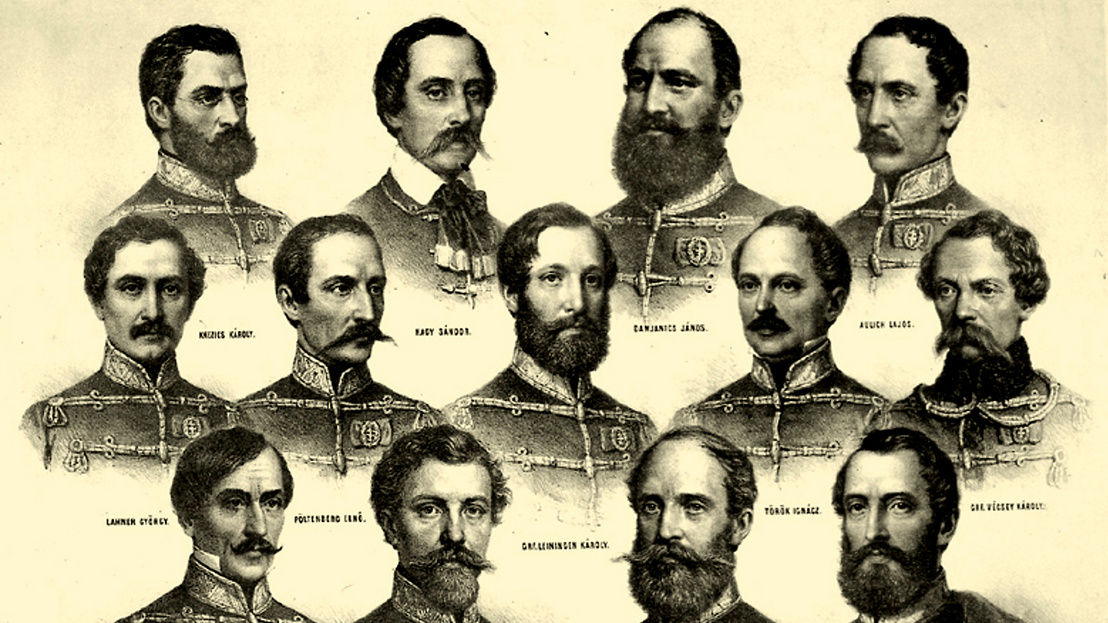175 years ago today, on October 6, 1849, Prime Minister Count Lajos Batthyány was executed in the yard of the Újépélet in Pest, and in Arad in 1848-49. we remember the thirteen national defense officers of the 1990 war of independence - the martyrs of Arad.
The martyrs of Arad were executed on October 6, 1849, after the fall of the War of Independence, on the first anniversary of the Vienna Revolution and the assassination of the Imperial Minister of War Theodor Baillet von Latour. Although sixteen army officers were executed in Arad, the national memory primarily counts the thirteen officers executed on this day and the prime minister:
• Dessewffy Aristid,
• Ernő Kiss,
• József Schweidel,
• Ernő Poeltenberg,
• Ignác Török,
• György Láhner,
• Károly Knezić (Knézich),
• József Nagysándor,
• Károly Leiningen-Westerburg,
• Lajos Aulich,
• János Damjanich,
• Generals Károly Vécsey,
• Colonel Vilmos Lázár, as well as
• Prime Minister Lajos Batthyány.
Between August 1849 and February 1850, three more army officers were executed in Arad:
On August 22, 1849, Norbert Ormai, the commander of the hunting regiments, on October 25, Colonel Lajos Kazinczy, and on February 19, 1850, Lieutenant Colonel Ludwig Hauk. National Guard Major General János Lenkey also died in the Arad Castle Prison.
Judge, prosecutor, lawyer in one person
Prime Minister Lajos Batthyány was arrested on January 8, 1849. Initially, conceptual accusations were made against him that they could not prove in any way. In any case, he was interrogated ten times between February 12 and March 26 to prove the charges. Among other things, he was accused of contacting foreign powers or playing a role in the preparation of the October 6, 1848 revolution in Vienna. Even some of his prime ministerial actions were brought up as charges, even though he had the right to do so under the April laws.
The Batthyány trial was obviously a political matter, which was also followed at the highest level. On August 30, the military court sentenced Batthyány to death by hanging. Military Judge Ludwig Leuzendorf, who served as both prosecutor and defense attorney, submitted a petition for clemency, in which he wrote:
I was instructed to speed up the process if possible, which had a very disturbing effect on the necessary deliberation and calm consideration.
According to legal historians, the court-martial was persuaded to issue the death sentence by the fact that Ferenc József would pardon Batthyány. On August 31, the Austrian Council of Ministers called on Haynau to submit all death sentences to the Council of Ministers for prior approval. However, Ferenc József had already decided two days earlier, on August 29, that Haynau was only obliged to report after the execution of the sentences. And the camp sergeant had no intention of granting a pardon, and ordered the execution of the sentence on October 3. On the last visit, his wife smuggled in a dagger, with which the Count inflicted serious injuries on his neck. But he survived, and they fixed him up to such an extent that he was executed on October 6 in the courtyard of the New Building (Neugebäude) in Pest. Batthyány knelt before the firing squad and shouted:
Long live the homeland! Get on it, hunters!
Cruel reprisals
During the cruel reprisals that followed the fall of the 1848-49 revolution and war of independence, around one hundred and fifty people were executed, while the number of those imprisoned and sentenced to forced labor numbered in the thousands, and tens of thousands of former national defense soldiers were conscripted into the imperial army.
As for the Arad martyrs, they were active or retired imperial officers at the beginning of the War of Independence, and at the end of the War of Independence, one of them held the rank of lieutenant general, eleven major generals and one colonel in the national army.
According to historian Péter Borhegyi, the verdicts were handed down even before the proceedings started. Haynau would have executed all former Imperial-Royal officials with an accelerated procedure, and the order of the Austrian Council of Ministers on August 20 prevented him from doing so, as it was not a summary judgment, but a military court that decided. Since the camp sergeant continued to insist on the strictest sentences, the outcome of the trials was clear - at the same time, he was unable to carry out the even greater carnage he had previously planned.
On September 26, 1849, the imperial court-martial sentenced all military officers to death by hanging. In his four main cases, the sentence was "combated" to death by bullet.
On October 6, at dawn, Colonel Vilmos Lázár and Generals Aristzid Dessewffy, Ernő Kiss and József Schweidel were the first to be led to the base of the ramparts, where twelve soldiers carried out their "mercy" execution by bullet. The others, i.e. generals Ernő Poeltenberg, György Lahner, Károly Knezić (Knézich), József Nagysándor, Count Károly Leiningen-Westerburg, Lajos Aulich, János Damjanich and Count Károly Vécsey, were hanged on gallows farther from the castle, which had been assembled the previous days. Ignác Török had a heart attack before the executioner could finish him off.
Where do they rest?
The martyrs were buried one by one at the place of their execution, but by paying off the guards, the corpses of several generals were also secretly transported from their first burial place.
On October 6, 1974, the 125th anniversary of the execution, the remains of the five generals in the Arad museum and three martyrs preserved in the Palace of Culture, together with the exhumed ashes of Láhner, Leiningen-Westerburg and Damjanich, were erected in 1884, at the supposed place of the execution it was placed in a crypt under an obelisk.
Thus, with the exception of Aristid Dessewffy and Ernő Kiss, the martyrs of Arad are now resting in one place.
After the execution, Dessewffy's remains were secretly transported by his relatives to Margonya, where he has been resting ever since, while Ernő Kiss, who was executed by a bullet, was laid to rest in the family crypt, in the Catholic church in Elemér.
National Day of Mourning
Until 1867, the martyrs of Arad could only be remembered in secret, but after the agreement, October 6 became a national day of mourning. During the Horthy era, the importance of the memorial day continued to grow, and it was not even banned during the communist period, since there was no state day of mourning in the Kádár regime, but the martyrs were commemorated in schools and newspapers.
After the regime change, in 2001, by decree of the first Orbán government, October 6 - the day of the defeat of the 1956 revolution and freedom struggle, along with November 4 - was declared a national day of mourning.
Featured Image: Wikipedia













